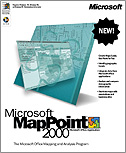 |

|
|
|
Where did MapPoint 2000 Come From?Our publisher looks at the product design and marketing considerations behind MapPoint 2000. Based in part on a recent visit by the author with the MapPoint 2000 team.

Microsoft & Geography Microsoft's geographic products include: Expedia, Streets 98, Trip Planner 98, Encarta 98, and soon, MapPoint 2000. More than 100 people are involved in developing and maintaining geographic products at Microsoft's Redmond, Washington campus. Each of these products resides in a central map database called Alexandria. Alexandria is a set of digital files in excess of 50 gigabytes that contains all of the geographic assets of Microsoft, seamed together in a single database. When a new release of one of the above products is prepared, a query to Alexandria extracts the layers that are needed for that product. At any given time, about a dozen cartographers are at work in maintaining and extending Alexandria. They do so on workstations running ESRI's ARC/INFO. Designing & Developing MapPoint The core of the development team implementing MapPoint came to Microsoft in 1994 with the acquisition of British-based Automap. Ian Mercer was head of Automap; he now leads MapPoint development. One might expect that Microsoft would have substantially staffed the programming team with people from the GIS software development industry. However, only one team member, Dan Cory, who was part of ESRI’s ArcView 2 effort, comes from that arena.
The idea for MapPoint 2000 grew from Microsoft's elementary mapping feature that was first introduced in Excel 5.0. This feature, originally called Datamap and now named Microsoft Map, was designed to develop simple maps inside the Excel spreadsheet, based on spreadsheet data. The technology in Microsoft Map is licensed from MapInfo and is based on their MapX technology. For a variety of reasons, this feature was never widely used. However, Microsoft market research discovered that Excel users would have liked to use it! How Did Microsoft Know? As part of its user research, Microsoft creates "instrumented" versions of its office products and distributes these to participating end-user organizations. These versions are augmented with little "watcher" programs that record every single keystroke and mouse-click that users make, and the results are forwarded to Microsoft product research. Among the “watcher” findings: Fully 17% of Excel users clicked on the Map icon. In the fall of 1997, Microsoft conducted extensive focus group sessions devoted to business mapping. These sessions confirmed the interest of Office users in elementary mapping. They also contributed to the short list of key features and benefits that these users wanted. At the top of this list was the need to quickly and easily locate an address and draw a map around that address. Finally, the MapPoint team interviewed more than 5,000 Office users. In designing MapPoint, Microsoft's approach differed radically from that heretofore pursued by the GIS industry. According to company officials, the product was built "up from the bottom." Instead of looking at heavy-duty GIS or desktop mapping systems and deciding what to "leave out," Microsoft used its focus group data to develop a product whose features and benefits flowed upward from the Office user's requirements. Consequently, the resulting product is unusual and in many ways, it is a radical departure from “traditional” desktop mapping products. MapPoint is an unabashedly "closed" system, geographically; no maps can be added. While this may seem strange at first, it allows Microsoft to remove all layer handling from the hands of the user. While MapPoint 2000 is "closed" mapwise, it is extraordinarily "open" with respect to tabular data. Loading data - especially from MS Office applications - is a well-executed and powerful feature. Marketing the Product Listening to Microsoft on the subject of marketing brings to mind Fitzgerald's aphorism about the rich: they're not like you and me! The MapPoint marketing team does not think in terms of gaining share in any existing market; they are out to create a new market. Since MapPoint 2000 will be a member of the Microsoft Office family, it is the penetration of Office users that matters most to its marketing strategy. Microsoft develops goals for MapPoint in terms of "attach" rates to MS Office: for every 1,000 copies of Office that are sold, how many copies of MapPoint can be "attached" to those sales? This thinking is reflected in the promotional methods that Microsoft will use. For instance, MapPoint shelf displays will be an integral part of the Office 2000 kiosks that we'll all see in every computer retail store across the country this spring. This “attachment” concept gets very interesting when you realize that there are somewhere between 40 and 50 million Microsoft Office users in the U.S. market! And Office 2000 is the first upgrade since Office 97. With those facts in mind, it is very tempting to play the spreadsheet game. For example, if 30 million upgrades and new-user copies of Office are sold in its first year, and if MapPoint attaches itself to just 1% of those sales; then Microsoft will have probably tripled the number of U.S. users of desktop mapping. Betz would not disclose either the unit or the dollar goals that the MapPoint team has set for itself. Most instructive, perhaps, are the paradigms held by two Microsoft managers, Mark Young and John Betz. Young is responsible for all Office Bookshelf marketing at Microsoft. Since MapPoint is a part of the Interactive Media Group, its marketing is a part of Young’s responsibility. Young compares the potential of MapPoint to that of Microsoft PowerPoint at its introduction. Betz, Product Planner for MapPoint 2000, uses a different, but similarly successful Office product as his point of comparison: Microsoft Access. Betz was a member of the Access team during its introduction in 1991/1992. At that time, the entire database market was barely over 1 million users. Access' year-one goal was 100,000 seats; by the tenth month, that goal had been exceeded ten-fold. And of course Access went on to define the mass market for desktop databases. It has since become a standard part of Microsoft Office, with tens of millions of users. Heady stuff for the future of desktop mapping.
 Author: Scott Elliott Author: Scott ElliottEmail: scott.elliott(AT)directionsmag.com URL: http://www.directionsmag.com Scott Elliott enjoys Amis, Ellison, Ford, Hardy, Percy, Tolstoy, Turgenev and some living writers. He is Publisher of Directions and MP2K magazines.
|
|
|||||||||||||||||||||||||||||||||||||||||||||||||||||||||||||||||||
|
|||||||||||||||||||||||||||||||||||||||||||||||||||||||||||||||||||||






